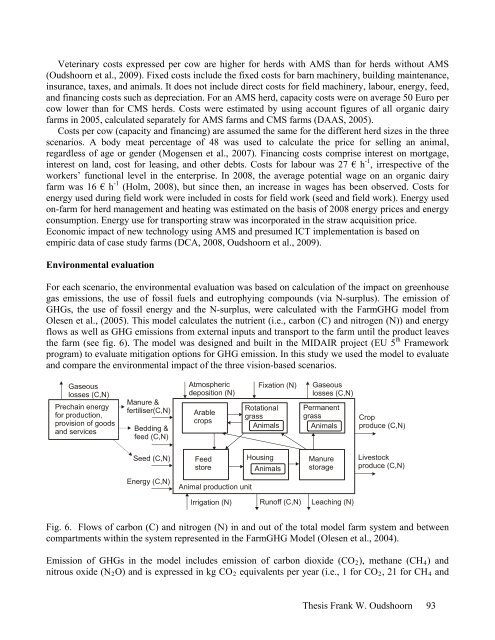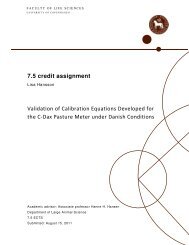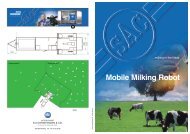Innovative Technology and Sustainable Development of Organic - 1.
Innovative Technology and Sustainable Development of Organic - 1.
Innovative Technology and Sustainable Development of Organic - 1.
You also want an ePaper? Increase the reach of your titles
YUMPU automatically turns print PDFs into web optimized ePapers that Google loves.
Veterinary costs expressed per cow are higher for herds with AMS than for herds without AMS<br />
(Oudshoorn et al., 2009). Fixed costs include the fixed costs for barn machinery, building maintenance,<br />
insurance, taxes, <strong>and</strong> animals. It does not include direct costs for field machinery, labour, energy, feed,<br />
<strong>and</strong> financing costs such as depreciation. For an AMS herd, capacity costs were on average 50 Euro per<br />
cow lower than for CMS herds. Costs were estimated by using account figures <strong>of</strong> all organic dairy<br />
farms in 2005, calculated separately for AMS farms <strong>and</strong> CMS farms (DAAS, 2005).<br />
Costs per cow (capacity <strong>and</strong> financing) are assumed the same for the different herd sizes in the three<br />
scenarios. A body meat percentage <strong>of</strong> 48 was used to calculate the price for selling an animal,<br />
regardless <strong>of</strong> age or gender (Mogensen et al., 2007). Financing costs comprise interest on mortgage,<br />
interest on l<strong>and</strong>, cost for leasing, <strong>and</strong> other debts. Costs for labour was 27 € h -1 , irrespective <strong>of</strong> the<br />
workers’ functional level in the enterprise. In 2008, the average potential wage on an organic dairy<br />
farm was 16 € h -1 (Holm, 2008), but since then, an increase in wages has been observed. Costs for<br />
energy used during field work were included in costs for field work (seed <strong>and</strong> field work). Energy used<br />
on-farm for herd management <strong>and</strong> heating was estimated on the basis <strong>of</strong> 2008 energy prices <strong>and</strong> energy<br />
consumption. Energy use for transporting straw was incorporated in the straw acquisition price.<br />
Economic impact <strong>of</strong> new technology using AMS <strong>and</strong> presumed ICT implementation is based on<br />
empiric data <strong>of</strong> case study farms (DCA, 2008, Oudshoorn et al., 2009).<br />
Environmental evaluation<br />
For each scenario, the environmental evaluation was based on calculation <strong>of</strong> the impact on greenhouse<br />
gas emissions, the use <strong>of</strong> fossil fuels <strong>and</strong> eutrophying compounds (via N-surplus). The emission <strong>of</strong><br />
GHGs, the use <strong>of</strong> fossil energy <strong>and</strong> the N-surplus, were calculated with the FarmGHG model from<br />
Olesen et al., (2005). This model calculates the nutrient (i.e., carbon (C) <strong>and</strong> nitrogen (N)) <strong>and</strong> energy<br />
flows as well as GHG emissions from external inputs <strong>and</strong> transport to the farm until the product leaves<br />
the farm (see fig. 6). The model was designed <strong>and</strong> built in the MIDAIR project (EU 5 th Framework<br />
program) to evaluate mitigation options for GHG emission. In this study we used the model to evaluate<br />
<strong>and</strong> compare the environmental impact <strong>of</strong> the three vision-based scenarios.<br />
Fig. 6. Flows <strong>of</strong> carbon (C) <strong>and</strong> nitrogen (N) in <strong>and</strong> out <strong>of</strong> the total model farm system <strong>and</strong> between<br />
compartments within the system represented in the FarmGHG Model (Olesen et al., 2004).<br />
Emission <strong>of</strong> GHGs in the model includes emission <strong>of</strong> carbon dioxide (CO2), methane (CH4) <strong>and</strong><br />
nitrous oxide (N2O) <strong>and</strong> is expressed in kg CO2 equivalents per year (i.e., 1 for CO2, 21 for CH4 <strong>and</strong><br />
Thesis Frank W. Oudshoorn 93




